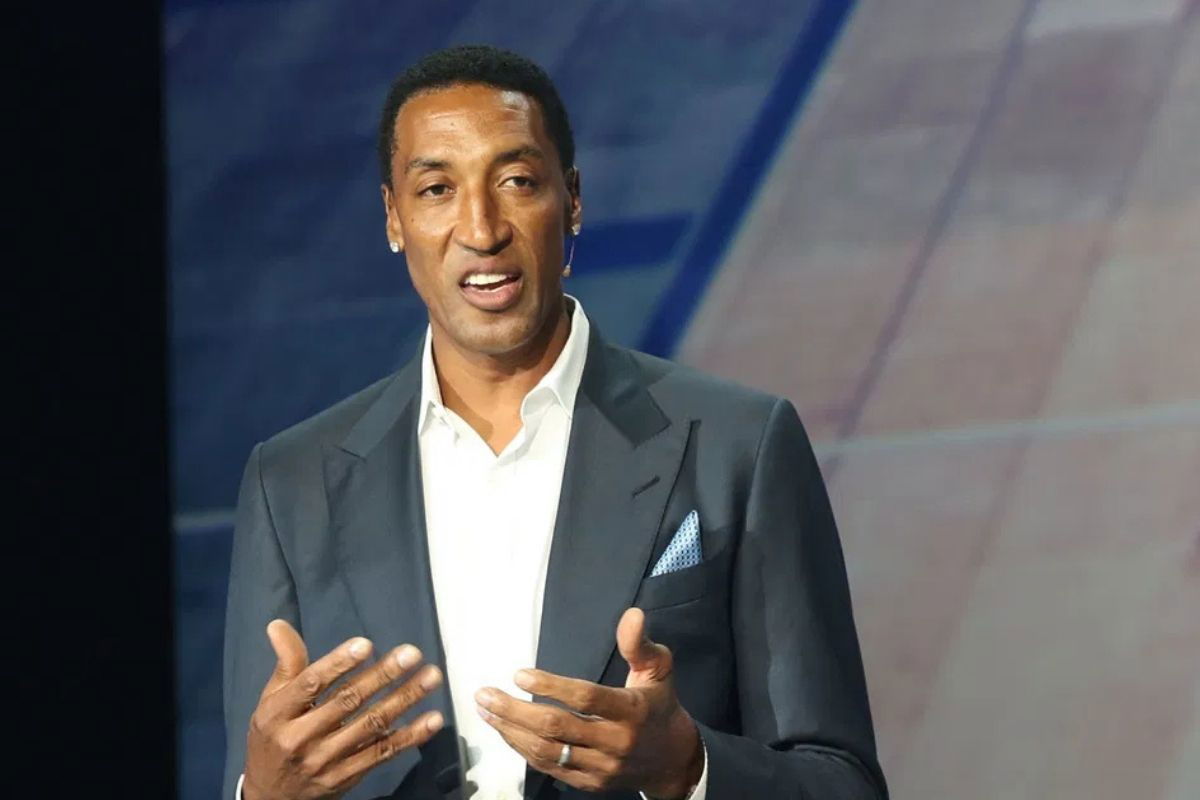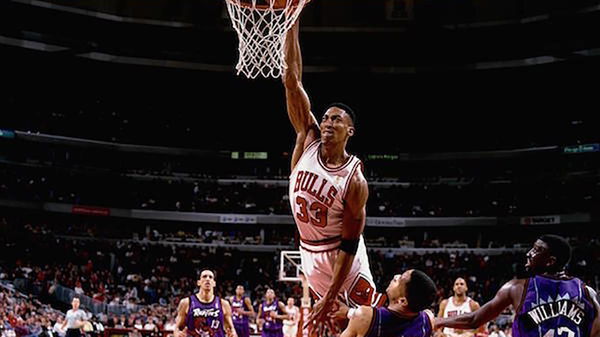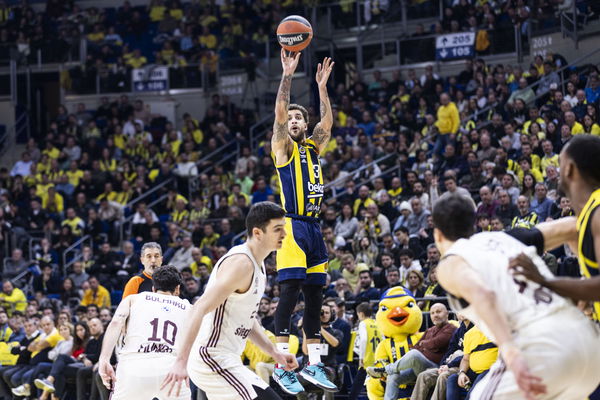
Getty
MIAMI, FL – FEBRUARY 04: Scottie Pippen Attends Market America Conference 2016 at American Airlines Arena on February 4, 2016 in Miami, Florida. (Photo by Aaron Davidson/Getty Images)

Getty
MIAMI, FL – FEBRUARY 04: Scottie Pippen Attends Market America Conference 2016 at American Airlines Arena on February 4, 2016 in Miami, Florida. (Photo by Aaron Davidson/Getty Images)
Watch What’s Trending Now!
“I would go in the gym and just work shooting one, and if I miss it, grab it and force myself to push it back and shoot again.” That’s Scottie Pippen—grinding in silence, perfecting the jump shot that would later help redefine what a forward could be. Back then, the mid-range and three-point jump shot were weapons. Today? They’re afterthoughts in a league obsessed with dunks and deep threes. That kind of dedication—and the art of the jump shot itself—feels like a lost craft in today’s American basketball. But Scottie Pippen didn’t mean to ruffle feathers.
He wasn’t trying to stir controversy or go viral. Scottie Pippen shot 44.7% (2446/5467) overall and 33.3% (544/1635) from three in 470 games in his 17-season career—but that didn’t come easy, so his statements hold value. “I hadn’t built that respect yet where I could just pull up that shot,” he admitted on The Jump, recalling how teams dared him to shoot early on. So he went to work, drilling shot after shot until defenders had no choice but to step out. At one point, he even touched 37% from deep. And for someone like him, to see the charm fade, it hits. It hurts. And here he is, with his truth bomb.
ADVERTISEMENT
“A lot of Americans have lost jobs because we haven’t mastered the advantage of shooting the ball like our European counterparts,” you pause. He’s not wrong—and that truth cuts deep. The game has changed. Once ruled by explosive athletes, bruising defenders, and iso scorers, basketball now revolves around one thing: shooting. If you can’t knock down a jumper, you’re a liability. And Pippen, who once ruled the hardwood without needing to shoot threes in bulk, knows that in today’s NBA, even he would be expected to space the floor.
Scottie Pippen’s point isn’t just about individual players—it’s about a system. International players like Luka Dončić, Nikola Jokić, Victor Wembanyama, and Shai Gilgeous-Alexander aren’t just stars—they’re the products of a basketball culture that drills footwork, spacing, and shooting from day one. Across Europe and beyond, teens grow up in pro systems where shooting is a non-negotiable. In the U.S., too often, the focus is on flash over fundamentals—highlight-reel dunks and viral handles before catch-and-shoot mechanics. And it shows. NBA scouts have quietly echoed this for years: international players are coming in more polished, more team-ready, and with a jumper that travels.

Getty
CHICAGO – 1997: Scottie Pippen #33 of the Chicago Bulls goes up for a slam dunk against the Toronto Raptors during an NBA game circa 1997 at the United Center in Chicago, Illinois. NOTE TO USER: User expressly acknowledges and agrees that, by downloading and/or using this Photograph, user is consenting to the terms and conditions of the Getty Images License Agreement. Mandatory Copyright Notice: Copyright 1990 NBAE (Photo by Barry Gossage/NBAE via Getty Images)
It’s not that America lacks talent—guys like Curry, Tatum, and Edwards are still evolving the game. But what Pippen’s saying is this: the NBA is now a global league, and skill is the new passport. It doesn’t matter where you’re from; if you can’t shoot, someone else will take your spot. The last four MVPs? All international. The future pipeline? Overflowing with global talent that grew up mastering the mechanics of American systems, are now scrambling to re-teach. Pippen’s words aren’t just a critique—they’re a wake-up call. Because in today’s NBA, if the shot isn’t falling, neither are your chances.
ADVERTISEMENT
ADVERTISEMENT
Why are European players better than the Americans?
ADVERTISEMENT
For years, the NBA was America’s playground. But now? It’s more like a European invasion—and not the hostile kind. It’s calculated, fundamental, and, frankly, pretty beautiful to watch. As Kobe Bryant once put it, “European players are just way more skillful. They are just taught the game the right way at an early age.” This isn’t just Kobe nostalgia-talking. He grew up in Italy and saw firsthand how basketball was taught abroad—how footwork, passing, balance, and reading the game were prioritized over flash. In Europe, you don’t get points for doing five crossovers if you can’t read a double team.
What’s driving this divide? A lot of fingers point straight at AAU basketball in the U.S. Kendrick Perkins once said European players: “are disciplined, they don’t cause trouble, they play the right way.” Kobe doubled down years ago, calling AAU “horrible, terrible… It doesn’t teach our kids how to play the game at all.” It’s a cash-driven system where, as Josh Smith puts it, “these coaches aren’t coaching these kids right… they letting them do what the f— they wanna do.” Instead of drilling fundamentals, American youth basketball tends to glorify highlights, athleticism, and raw talent.
Meanwhile, European kids are getting coached like pros from the time they’re 12. “I didn’t play pick-and-roll until I was like 15,” Franz Wagner told JJ Redick, explaining how he grew up in Berlin practicing give-and-go cuts and footwork instead of ISO ball. “We had this game in practice—if you get 10 passes in a row, you get a point. It wasn’t even about scoring.” The contrast couldn’t be starker. In Europe, you mess up? You sit. No special treatment. No coddling. Former coach Doc Rivers agrees, warning that “European players are better prepared coming into the league. They’re competitors. A lot of our young players are not.”

All of this can be seen in the light of recent developments around NBA expansion into Europe—something that no longer feels like a pipe dream. In recent months, NBA deputy commissioner Mark Tatum confirmed that talks are underway to deepen ties with the EuroLeague, with exhibition games, increased cross-competition, and even the possibility of an eventual NBA Europe division. If the NBA is truly a global game, then embracing the EuroLeague might just be the future—and a wake-up call for American basketball to fix what’s broken.
ADVERTISEMENT
ADVERTISEMENT
ADVERTISEMENT
ADVERTISEMENT

